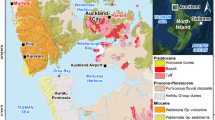Abstract.
Distributions of pyroclastic deposits from the main explosive events at Somma-Vesuvio during the 8,000-year B.P.–A.D. 1906 time-span have been analysed to provide maps of volcanic hazard for long-term eruption forecasting. In order to define hazard ratings, the spatial distributions and loads (kg/m2) exerted by the fall deposits on the roofs of buildings have been considered. A load higher than 300 kg/m2 is defined as destructive. The relationship load/frequency (the latter defined as the number of times that an area has been impacted by the deposition of fall deposits) is considered to be a suitable parameter for differentiating among areas according to hazard rating. Using past fall deposit distributions as the basis for future eruptive scenarios, the total area that could be affected by the products of a future Vesuvio explosive eruption is ~1,500 km2. The perivolcanic area (274 km2) has the greatest hazard rating because it could be buried by pyroclastic flow deposits thicker than 0.5 m and up to several tens of metres in thickness. Currently, the perivolcanic area also has the highest risk because of the high exposed value, mainly arising from the high population density.
Similar content being viewed by others
Author information
Authors and Affiliations
Additional information
Electronic Publication
Rights and permissions
About this article
Cite this article
Lirer, L., Petrosino, P., Alberico, I. et al. Long-term volcanic hazard forecasts based on Somma-Vesuvio past eruptive activity. Bull Volcanol 63, 45–60 (2001). https://doi.org/10.1007/s004450000121
Received:
Accepted:
Issue Date:
DOI: https://doi.org/10.1007/s004450000121




